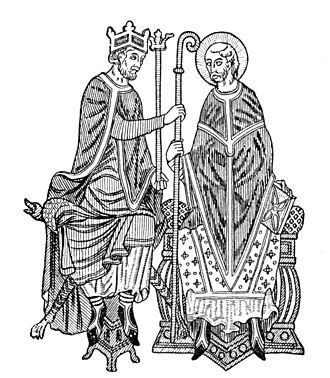"The second half of the eleventh century was a particularly decisive time in the history of the church. To mention only three of the more important developments, the popes emerged as the leaders of an international reform movement in western Europe; they became involved in a dispute with the empire whose effects were to be long-lasting; and they directed the military efforts of Christendom against Islam, most notably in the First Crusade.
The papal reform movement, the investiture contest, and the crusades went far beyond any previous precedents for papal activity, and were to have a profound impact upon the future history of the church. Behind them lay one of the most remarkable features of this period: the influence of monasticism.
In general it has been rare for a monk to become pope, but from 1073 to 1118 the chair of St Peter was continuously occupied by men with monastic training, and monastie advisers were prominent in the formulation of papal policy. Monasticism was itself in turmoil, fot while existing abbeys were expanding rapidly many new ones were being founded and challenges to traditional ideals were being vigorously expressed. Yet monasticisrn was only one (although a very important) element in an international movement for the reform of the church and redefinition of the place of the laity within it. Behind these developments were major changes in society.
A new structure of lordship was emerging, along with a money economy and urban communities. Closely related with these social changes was a great expansion of learning, the first stages in the
movement which was to produce the distinctive medieval contribution to European Scholarship.
There were thus five great forces transforming the history of the church: papal revival, monastic renewal, international reform, social change, and the growth of learning. It is not easy to define their
niutual influence, or even to determine their chronological priority, since change necessarily took place over a long period, and at very different speeds in different parts of Europe."
source: The Papal Monarchy: The Western Church from 1050 to 1250 by Colin Morri; Illustration Myers, Philip Van Ness (1905), A medieval king investing a bishop with the symbols of office, source
The papal reform movement, the investiture contest, and the crusades went far beyond any previous precedents for papal activity, and were to have a profound impact upon the future history of the church. Behind them lay one of the most remarkable features of this period: the influence of monasticism.
In general it has been rare for a monk to become pope, but from 1073 to 1118 the chair of St Peter was continuously occupied by men with monastic training, and monastie advisers were prominent in the formulation of papal policy. Monasticism was itself in turmoil, fot while existing abbeys were expanding rapidly many new ones were being founded and challenges to traditional ideals were being vigorously expressed. Yet monasticisrn was only one (although a very important) element in an international movement for the reform of the church and redefinition of the place of the laity within it. Behind these developments were major changes in society.
A new structure of lordship was emerging, along with a money economy and urban communities. Closely related with these social changes was a great expansion of learning, the first stages in the
movement which was to produce the distinctive medieval contribution to European Scholarship.
There were thus five great forces transforming the history of the church: papal revival, monastic renewal, international reform, social change, and the growth of learning. It is not easy to define their
niutual influence, or even to determine their chronological priority, since change necessarily took place over a long period, and at very different speeds in different parts of Europe."
source: The Papal Monarchy: The Western Church from 1050 to 1250 by Colin Morri; Illustration Myers, Philip Van Ness (1905), A medieval king investing a bishop with the symbols of office, source
Support TemplarsNow™ by becoming a Patron, tipping us or buying one of our Reliable Books.

No comments:
Post a Comment